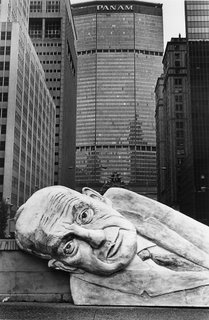
time to re-assess Robert Moses??
""Robert Moses and the Modern City" catalogues and illustrates Moses’s oeuvre in New York City - every pool, beach, neighborhood playground, city park, road and crossing, housing and urban renewal project, along with some miscellaneous ones, like the U.N. headquarters or the Queens Museum’s diorama of New York City - each with a lengthy explanatory and historical entry. (His vast projects on Long Island and upstate fall outside the scope of the book and exhibitions.) The cumulative effect is formidable, with more than 150 pages of projects. And not only are pools and parks redeemed, but highways, reconsidered from a technical-rational point of view, figure favorably. Thus, the Cross-Bronx Expressway, destroyer of urban fabric, becomes, according to the highway’s entry in the book, a “vital link in the city’s modern transport system.” And history strips Moses of authorial control: the road had already appeared in the 1929 Regional Plan of New York - if Moses hadn’t built it, someone else would have. The conflict over the “one mile” in East Tremont becomes representative not only of Moses’s power and inflexibility, but also of “the preeminence of three planning objectives: facilitating regional traffic flows, protecting parks, and reducing residential densities in low-income neighborhoods.” The importance of people, in this re-revision of Moses’s history, fades in comparison to the over-arching planning principles of the day..."